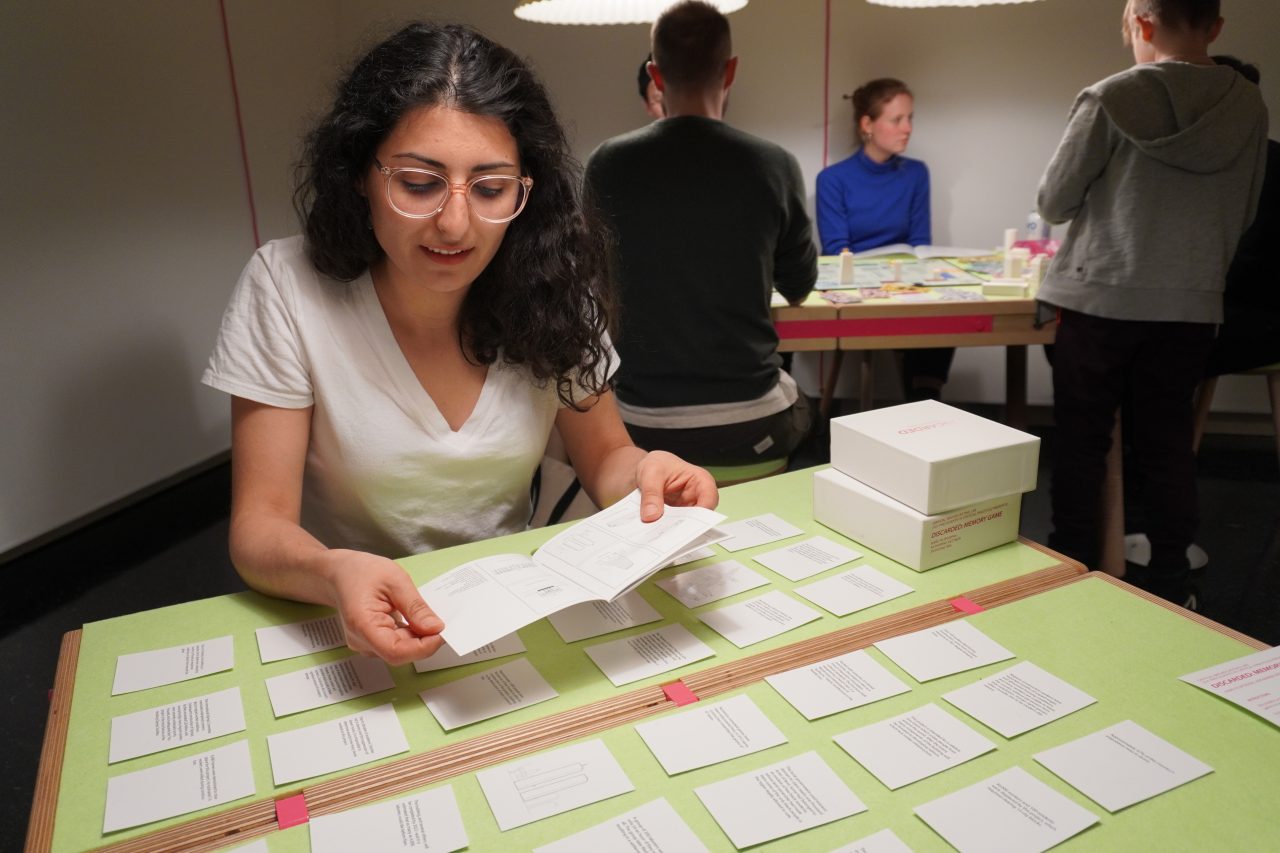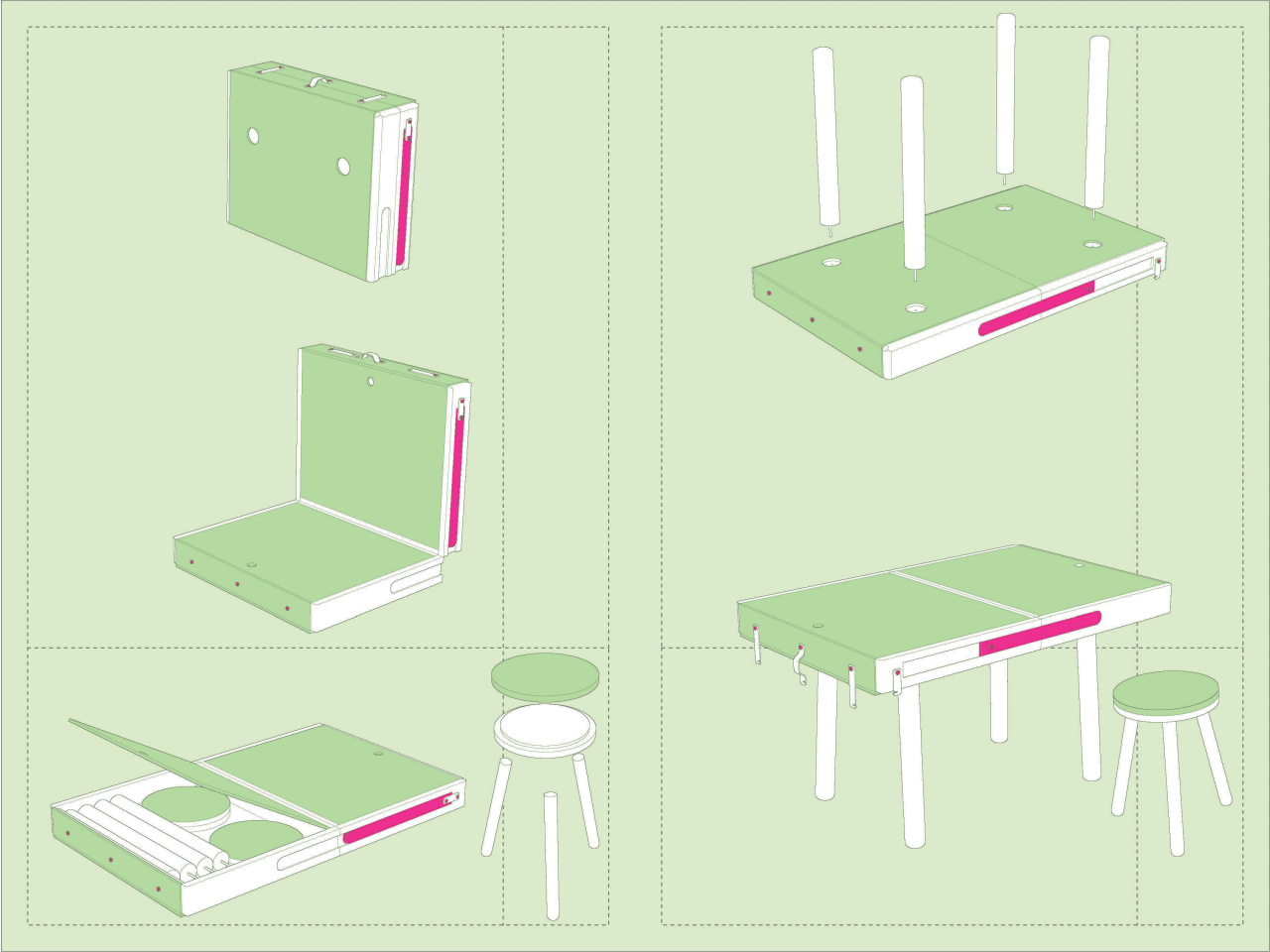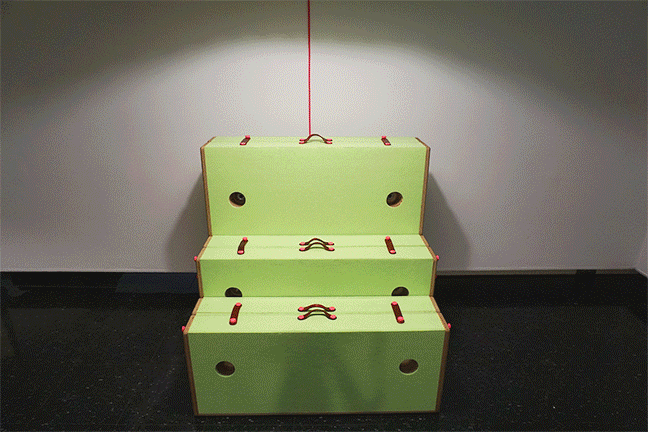We hope that PLAY ROOM invites the youthful abandon that accompanies play, though it is, at the same time, a space of protocol. Its gaming tables follow in a long lineage of furniture that has defined the military encampment, the Victorian-era pastime, and the corporate board room. This somewhat inconspicuous stage-setter — the table — invites, levels, “civilizes,” or entraps. in PLAY ROOM, the table delivers board – and card games, whose rules and mechanics are designed to examine a series of contemporary topics in architecture: starchitects, gentrification and urban development; violence and the abstractions with which historical complexity is sanitized and made palatable; markets for architecture portfolio prep schools; the entangled and multifarious identity of the contemporary global subject and experiments with collectivity and control. Come engage in these games with us. In PLAY ROOM we will contemplate their topics together through play.
Featuring games by: Rodrigo Escandón Cesarman, Ingrid Roede, Melissa Gutiérrez Soto, Nof Nathansohn, Nitzan Zilberman, Ryan Clement, Trevor Herman Hilker, Ana McIntosh, Jie Wu, Nare Filiposyan, Katharine Kettner, Jinyoung Sim, Syndney Cinalli, Stratton Coffman, Sarah Wagner, Cloe Yun Wang, Daisy Ziyan Zhang
PLAY DATE: Bartertown with Janette Kim (Urban Works Agency, All of the Above, CCA)
March 6 2020 at 6PM


PLAY ROOM is furnished with folding games tables, which store knock-down stools and lamps, for easy transportation. the deployability, materiality, and construction details of the pieces follow in a long lineage of furniture that has defined the military encampment, the Victorian-era pastime, and the corporate board room. This somewhat inconspicuous stage-setter — the table — invites, levels, “civilizes,” or entraps.
The folding desk was a mainstay of the European military and colonial campaigns of the 18th and 19th centuries. The table and the chest and the chair were cultural objects re-deployed across empire as instruments of power. Various folding mechanisms facilitated this deployment: in PLAYROOM, the custom hardware, powder coated pink, calls upon and ironizes this history.
The green felt of the games table emerges out of the Industrial Revolution. Socialized leisure activities appeared in the mid 19th century in response to The Factory Acts of 1833 and 1844, which regulated the work hours of children and women. The folding games tables which afforded the new found free time of the non-ruling classes can be read as constructs of class consciousness, reform ideology, extractive economics, and the expansive colonial apparatus. Games tables often used “exotic” woods and textiles from colonized territories; the Mahjong parlor and the Victorian parlor meet at the felted green surface.
While PLAY ROOM’s furniture works-through these histories of materialized power and protocol, its proportions, color and shape also invite youthful abandon. The sitting height of the table and stool are calibrated to induce the slight hunch of an adult engaged in child’s play.

-
Discarded
Nare Filiposyan, Katharine Kettner, Jinyoung Sim
Discarded is a matching game for two or more players.
The objective of the game is to earn more points than your opponent. To begin the game, shuffle the deck of cards then lay them out in an even grid with the image side face-down. Once cards are dealt in this manner, players should familiarize themselves with the facts that are now face up on the playing surface. All the cards depict structures on one side and corresponding facts on the other side.There are 3 card types:
An untold story card
A defensive card
A statistics cardThere is one card of each type in a set corresponding to an architectural case study. Players take turns to try and select a matching set. A player chooses three cards, then flips them over to see the structure on the other side. If all the cards match, the player collects the cards and earns 1 point. If the cards do not match, they are returned to their original face-down state. The game ends when all cards are collected. The player with the most points wins.
-
Identity Gamble
Rodrigo Escandón Cesarman, Ingrid Roede, Melissa Gutiérrez Soto, Nof Nathansohn, Nitzan Zilberman
Identity Gamble is a strategy game for two or more players. Identities are established, allegiances revealed, common traits discovered, and divergences divulged as players compete for cards. Using any and all documents carried on their person (henceforth referred to as “cards”), players compete to communicate, assert, manifest, profess, claim, prove, or verify Identity.
Objective
The objective of Identity Gamble is to collect all cards in play. Patrons converge at the playing field (kitchen table, airport floor, waiting area, lobby sofa, Play Room), each holding their covered hand of personal cards. The game is played in rounds, each player in turn declaring an identity associated with a card in their possession (e.g. student, female, currency, European, green-eyed citizen, etc.). Each card might be embedded with one or more Identity. All players must give up every complying card, adding them to the caller’s collection. If a faulty Identity is called, the original owner of the card can take it back. When a player is out of cards, they leave the game. Identity Gamble ends when one player, having revealed their shared categories of identification with all others, holds every card in play. -
Portfolio Agency
Cloe Yun Wang, Daisy Ziyan Zhang
Contents
1 game board, 1 set of hatch cards, 1 set of grid cards, 1 set of event cards, 1 die, 4 player pawnsObjective
The first player that reaches the final space is accepted to architecture school and wins the game.Preparation
Unfold and place the board on the table. Lay out hatch cards and grid cards in order. Shuffle event cards and place them in a deck face-downInstructions
Players take turns to toss the dice. The number shown on the dice indicates the steps to move forward. If a player stops on a grid with a question mark, that player draws the top card from the event deck. If player stops on a grid with graphics, check the hatch cards or grid cards with corresponding numbers on the back, read and follow the instructions (note that hatch cards only applies to players who have purchased portfolio agency service. Players without portfolio agency service, i.e. DIY players, should not check the card. Stop there and wait for next turn). If all cards for the grid that player stops on have already been taken by other players, stop and wait for the next turn. Otherwise, if player stops on a grid with only a number, no further action is needed. Stop there and wait for the next turn. -
Balls for all
Syndney Cinalli, Stratton Coffman, Sarah Wagner
Contents
Five body sleeves
One playing field
Five objective holes
One pit of entropyRules
Body sleeves must be worn at all times
If the ball ends up in the wrong hole, everyone loses
Everyone wins or everyone losesCollectives for Beginners
Five players without visual impairment
All players strive to guide five balls into the pit of entropy -
Highlinopoly
Ryan Clement, Trevor Herman Hilker, Ana McIntosh, Jie Wu
In 2009, the opening of the High Line would anchor an infrastructural spine along which a burgeoning $25 billion Hudson Yards development would thrive. Setting records as the largest private real estate development in United States history, the new far-west Midtown would undergo a decade of rapid growth and gentrification, transforming into a near-unrecognizable antithesis to the industrial landscape it once supported. Today, uber-luxury condominiums concentrated along the High Line’s public park-space exemplify the power of capitalist systems in place, and suggest, in a way we cannot ignore, that Architecture is playing a role. Ostensibly, the High Line, and the development that it feeds, create a space for people. In practice, they are spaces for assets, temples to the abstract markets at play.
Along the High Line, ostentatious façades glimmer like monumental trophies, a celebration of Capital through form and image and space. They are wrappers with more room for investments than inhabitants in dazzling mockery of a city facing imminent housing crisis. In this landscape, architecture works in service of capital flows initiated by the wealthy, participating in a bubble of blissful neglect toward urgent spatial needs of the city — complicit in decorating the space of the top percent. The success of the High Line highrise is impervious and unrelenting, incurring a demand that spirals even higher with each starchitect-anointed jewel box that arrives to consume an increasingly limited space.
Highlinopoly arrives as a confluence of critical research and nostalgic play. Processing metric data and current events through the framework of a kitchen-table classic, the game dwells in the shared space of Capital in order to present High Line development among abstractions of its economic and cultural reality. Wearing the hat of the speculative real estate developer, each player will race to establish their own fleet of luxury high rises and vie for dominion over their competition.






-
Games from Precedents in Critical Practice, Collective Architecture Studio, Agit Arch
-
Exhibition Team:
Trevor Herman Hilker
Jeffrey Landman
Rodrigo Escandón Cesarman
Ana Miljački
Jie Wu
Ana McIntosh
Jung In Seo -
Supported in part by the CAST Mellon Faculty Fellowship
-
With Thanks To:
Eli Keller
Sacha Moreau
Clarence Yi-Hsien Lee
Jaehun Woo
Emma Pfeiffer
Ben Hoyle
Charlotte D’Acierno
Jayson Kim
James Harrington
Jennifer O’Brien
Amanda Moore
